Just Saying…
Just found out that the CBLDF had a Facebook page (yeah, I’m slow), but I noticed that they’d like to get 5,000 members and they’re already at 4,920 as I write this. Seems awfully close to me.
Just found out that the CBLDF had a Facebook page (yeah, I’m slow), but I noticed that they’d like to get 5,000 members and they’re already at 4,920 as I write this. Seems awfully close to me.
From Mind TV (via Tom), comes this great bit of shop talk from one of America’s most thoughtful cartoonists. Would love to see a central repository of these kinds of videos someday. Cartoonists could learn a lot from each other.
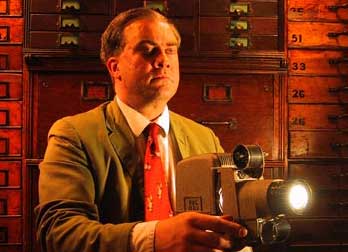
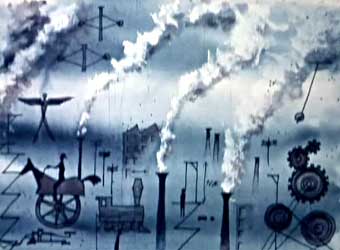
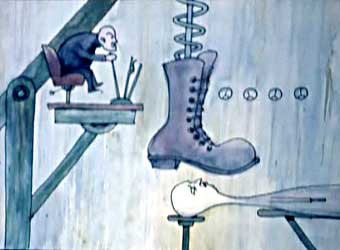
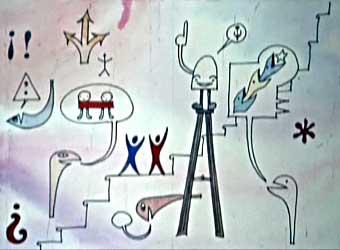
No one has had more influence over my art than my old friend, the legendary Brian Dewan. He’s a songwriter, composer, builder, music historian, and fine artist, but in my world he’s always been, first and foremost, a cartoonist, because he understands better than anybody how ideas and images can be distilled to their essence, a magic trick I’m still trying to learn.
I talk a lot about how Kurt Busiek got me into comics in junior high school, but despite a statistically-improbable cluster of geniuses my age growing up within a block of my house in Lexington, MA (including Brian’s amazing brother Ted whose photo of Brian I stole above), no one did more to unlock the mysteries of art for me than Brian.
One of Brian’s coolest inventions, his funny, touching, brilliant, insane, and unforgettable filmstrips, have been issued as a DVD collection from Bright Red Rocket. I can’t recommend them highly enough. Here’s an audio portrait of the talented Mr. Dewan, courtesy of NPR, which includes the filmstrip Innovations (from which the above screenshots were taken) if you’d like a sample.
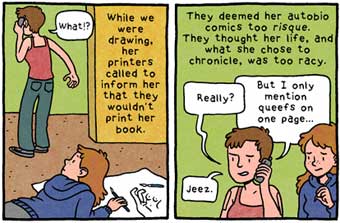 Lucy + Erika = Awesome. Hey, and there’s still time to order Erika’s new book and reward one of the many printers out there that aren’t prudes.
Lucy + Erika = Awesome. Hey, and there’s still time to order Erika’s new book and reward one of the many printers out there that aren’t prudes.
It took about 3 minutes in the mid-’90s for comic strips to take to the Web; like those newborn babies dropped in water that instantly know how to swim. If an online comic strip looked like its printed cousins, it was just as readable. If surfers had short attention spans, no problem. The Web was one big refrigerator, covered with magnets, waiting for something short, funny and recognizable to snap on to its audience.
Long form comics (the online equivalent of comic books and graphic novels) have had a harder road to follow. Fewer readers have the time or stamina for a web-based Maus or Watchmen during precious coffee breaks at work. And long, serious comics don’t always lend themselves to the kinds of conspicuous ads and light-hearted merchandise that have kept many daily strips afloat. Still, if a young artist is passionate enough to create a long form masterpiece they won’t let these limitations stop them and sooner or later they’ll find an audience.
But there’s one more obstacle, which is far more infuriating because it’s so pointless and unnecessary: The page designs of most long form webcomics suck donkey dick. Good artists and writers—including some of my favorite cartoonists in the world—force readers to sroll, then click, then read, then scroll, then read, then click, then scroll again for no other reason than a stubborn belief that all comics pages have to be taller than wide, and that all web pages need a metric ton of blinking crap at the top to work.
Long form comics are different from strips. If a cartoonist wants their readers to stick with a 60-page story about their Moroccan grandmother’s struggle with Diabetes, they need that reader to lose themselves in the story. That means keeping readers’ eyes on the page. Every time a reader looks away to navigate, they’re leaving the world of the story, and returning to the world of scrollbars and links.
The simplest solution—choosing screen-fitting pages and putting them near the top of the screen—is not rocket science. Charlie Parker’s Argon Zark did it over a decade ago (screens were smaller then), Justine Shaw, the first webcomics artist ever nominated for an Eisner, created a near-perfect format with Nowhere Girl in 2002 (making the entire page a next button), and Larson and O’Malley’s wonderful Bear Creek Apartments from 2008 had no trouble getting thousands of readers to click to the end.
But still the madness continues, and every day another dozen artists put their comics online using a format every bit as a annoying as a TV show that automatically changes channels every 3 minutes, while a four year-old stands directly in front of the screen, screaming the theme from Barney.
Which brings us to Yves Bigerel.
A lot of people have been pointing me to Yves’ two webcomics about webcomics over the last couple of weeks. If your own attention spans aren’t too taxed already, I hope you’ll consider reading both now from beginning to end (should only take about 6 minutes, they’re not too long):
Now, there are about a dozen issues raised in these comics that I’m not going to touch on. He’s actually heading in some directions that I’d be reluctant to go. But there’s no question that these comics struck a chord with artists and readers in the last few weeks, including me. And I think that one of the most refreshing aspects (“refreshing” as in a cool drink of water after five days in the desert) is the fact that navigating using Yves’ system is as simple and intuitive as breathing.
If that’s the message more cartoonists take to heart in the coming months, we may see some progress yet.
 Clearly it is the presence of the Giant Blue Brain which looks down upon this fair city.
Clearly it is the presence of the Giant Blue Brain which looks down upon this fair city.
Thank you to my gracious hosts for an exhilarating visit to Belgium’s charming capitol, and to The Mighty Brain to which I now pledge my everlasting obedience.
 The place I ate lunch at yesterday here in Brussels had a gorgeous display of alcohol bottles rising 14 feet on cherry wood shelves. The bottles were lit from above and below and within each shelf. I spent the entire lunch staring at them.
The place I ate lunch at yesterday here in Brussels had a gorgeous display of alcohol bottles rising 14 feet on cherry wood shelves. The bottles were lit from above and below and within each shelf. I spent the entire lunch staring at them.
I always loved the traditions of different bottle shapes and label styles. Whisky, vodka, brandy, scotch… There’s nothing stopping them from putting Jim Beam in Apple Juice bottles—it would be the exact same drink—but they never will. When I pass them in the supermarket aisles, I feel like I’m in a museum, or even a church. I imagine how much more I’d appreciate them if my body had developed a chemical dependency on their effects; how the experience of drinking would flash through my head at the mere sight of each one.
I’ve always suspected that I’d really like drinking if I ever got started. So I never have.
The restaurant accidentally charged me 13,000 dollars for lunch, instead of 13 dollars. They fixed the mistake, but last night I had to call long distance to my bank in the U.S. to get a hold on my card lifted after they thought it had been stolen. I’m taking it as a warning.
Fun fact: Scott also loves the smell of cigarettes and the charming clatter of roulette wheels.
 I don’t get to see it until I’m back in the States, but trust me: I lived through the dark years and no matter how bad it is, it could have been so, so much worse if it had come out when I was in knee pants.
I don’t get to see it until I’m back in the States, but trust me: I lived through the dark years and no matter how bad it is, it could have been so, so much worse if it had come out when I was in knee pants.
No consolation for Hitler, but some perspective for the rest of us.
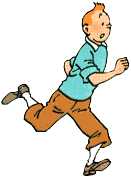 Off to Brussels for the Book Fair.
Off to Brussels for the Book Fair.
I was in Turnhout for a comics festival in late 2007 and I noticed something odd. It was moist, cool, and windy, and when I caught my own reflection in a shop window, my hair was blowing back into a small tuft directly over my forehead—exactly like Tintin. I mentioned this to cartoonist/genius Kevin Huizenga at dinner that night and he confirmed that he’d noticed his hair doing the same thing whenever he was in Belgium and had even written about it. Was Hergé a realist?
Updates might be spotty for a few days. Returning home Monday.
 Cartoonists are visual artists. We should all have better headshots. Everybody’s been enjoying the great photos of NYC comics artists that Seth Kushner has been taking, but I think my favorite is this one from a recent interview with James Kochalka. If anyone out there has a better headshot than that, I’d love to see it.
Cartoonists are visual artists. We should all have better headshots. Everybody’s been enjoying the great photos of NYC comics artists that Seth Kushner has been taking, but I think my favorite is this one from a recent interview with James Kochalka. If anyone out there has a better headshot than that, I’d love to see it.